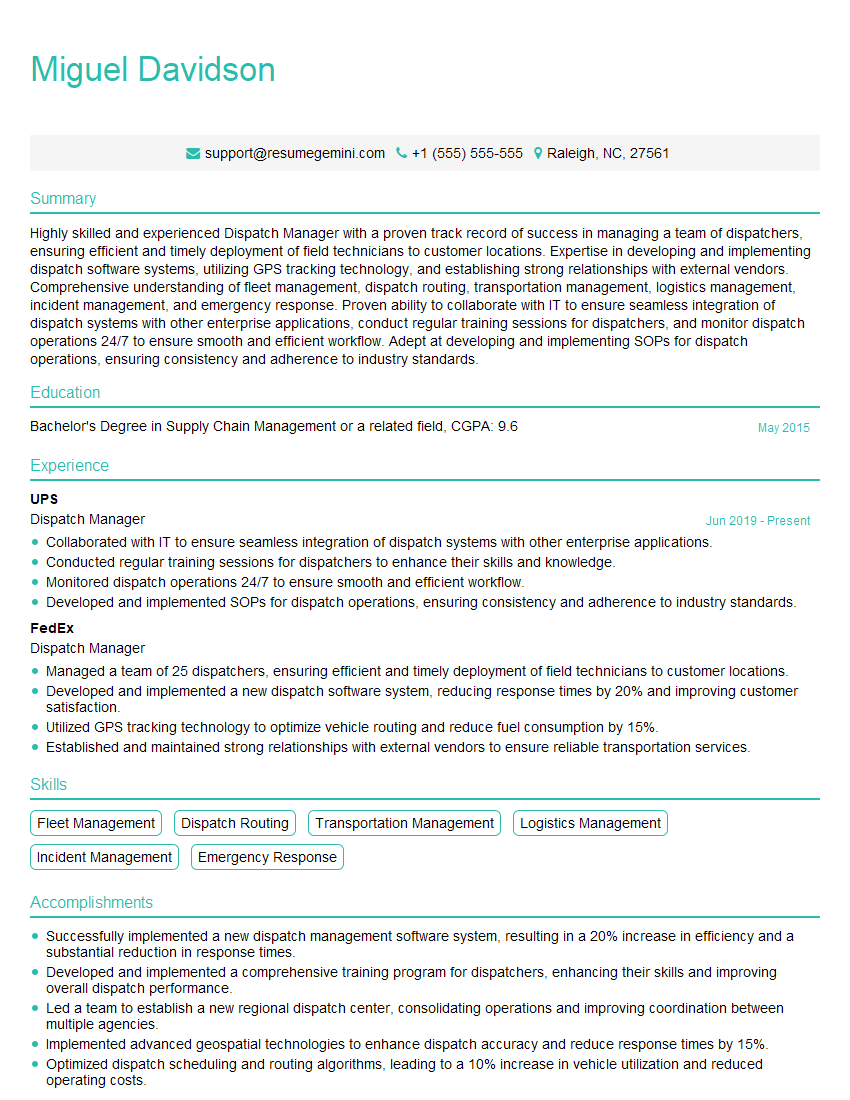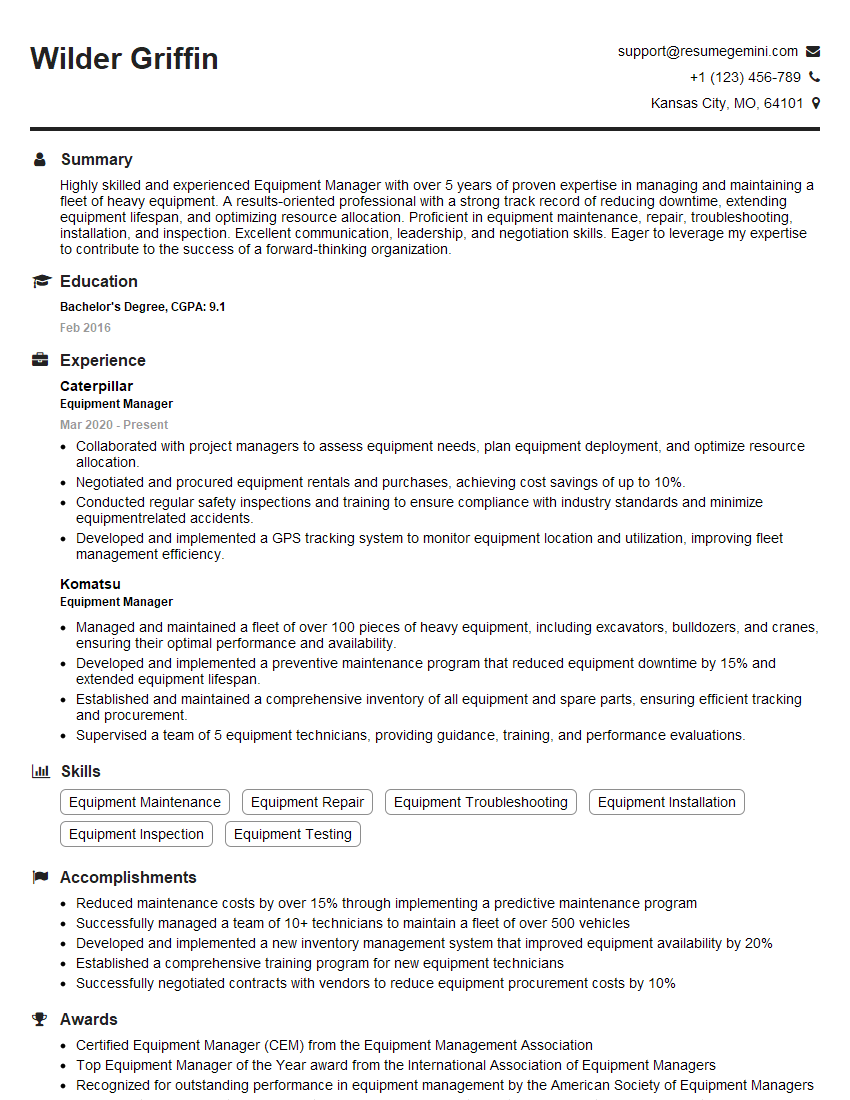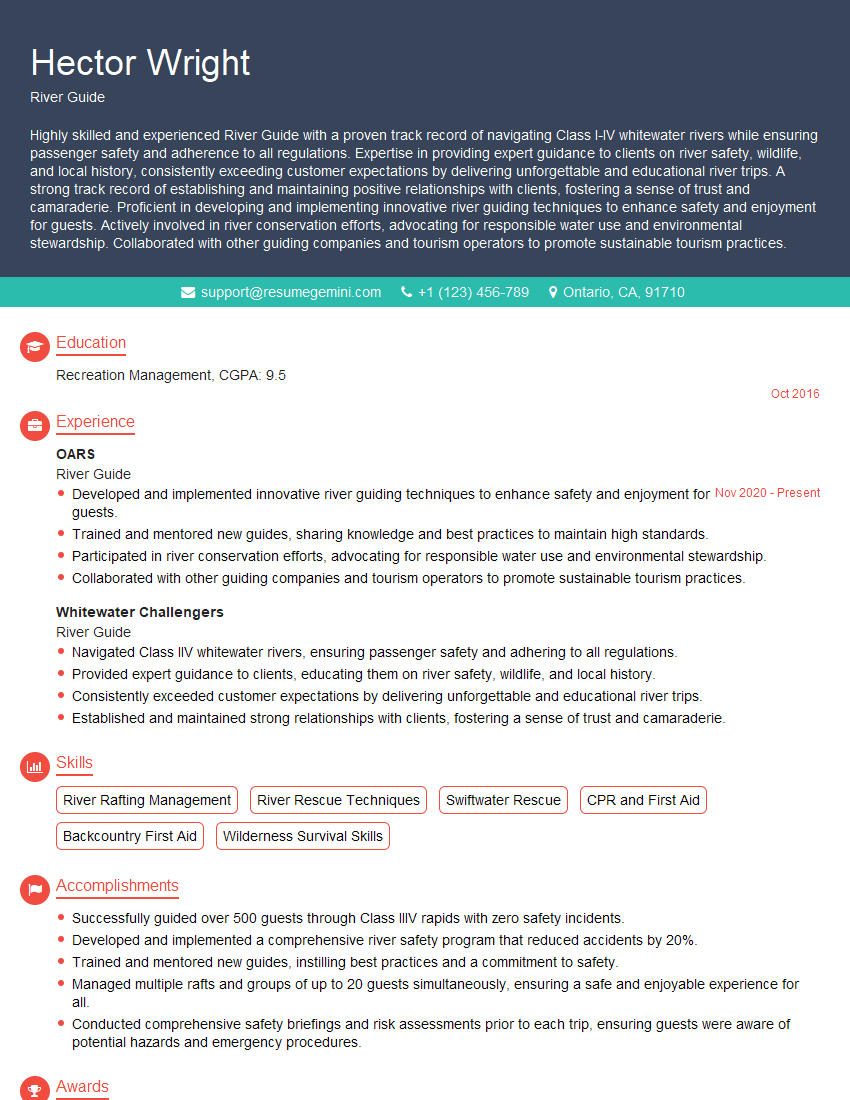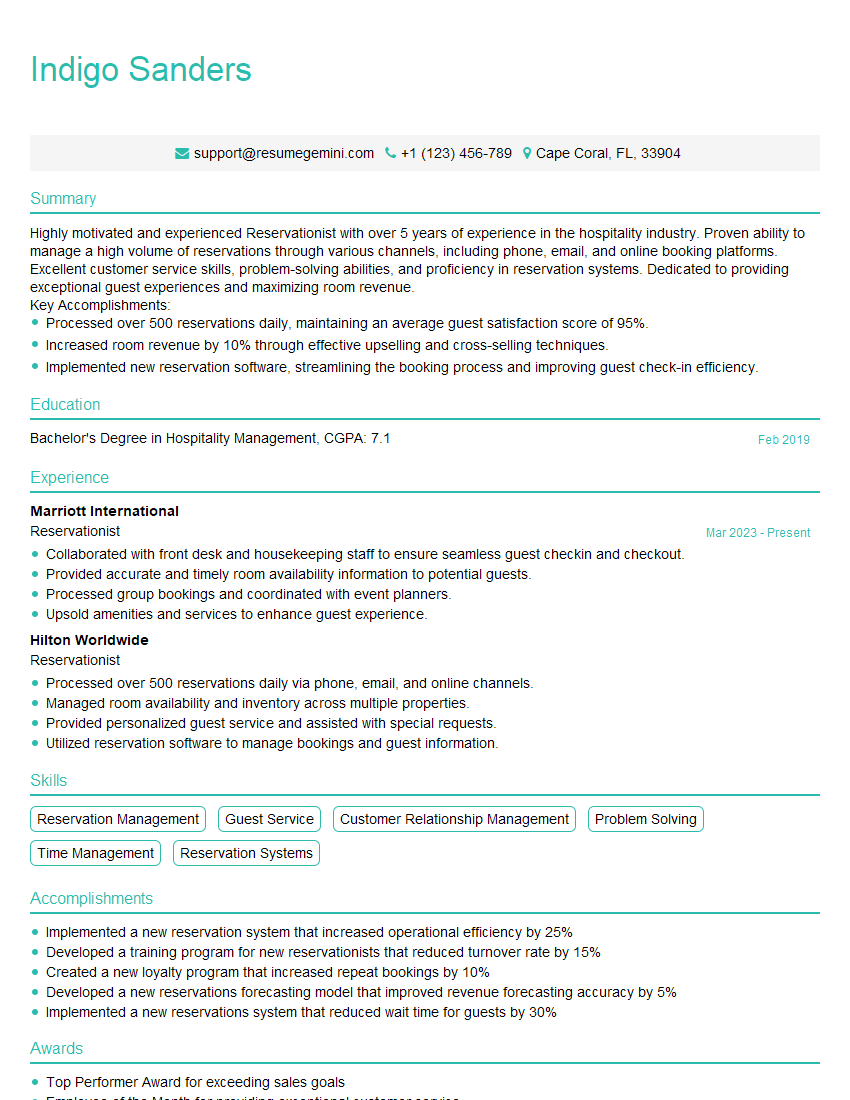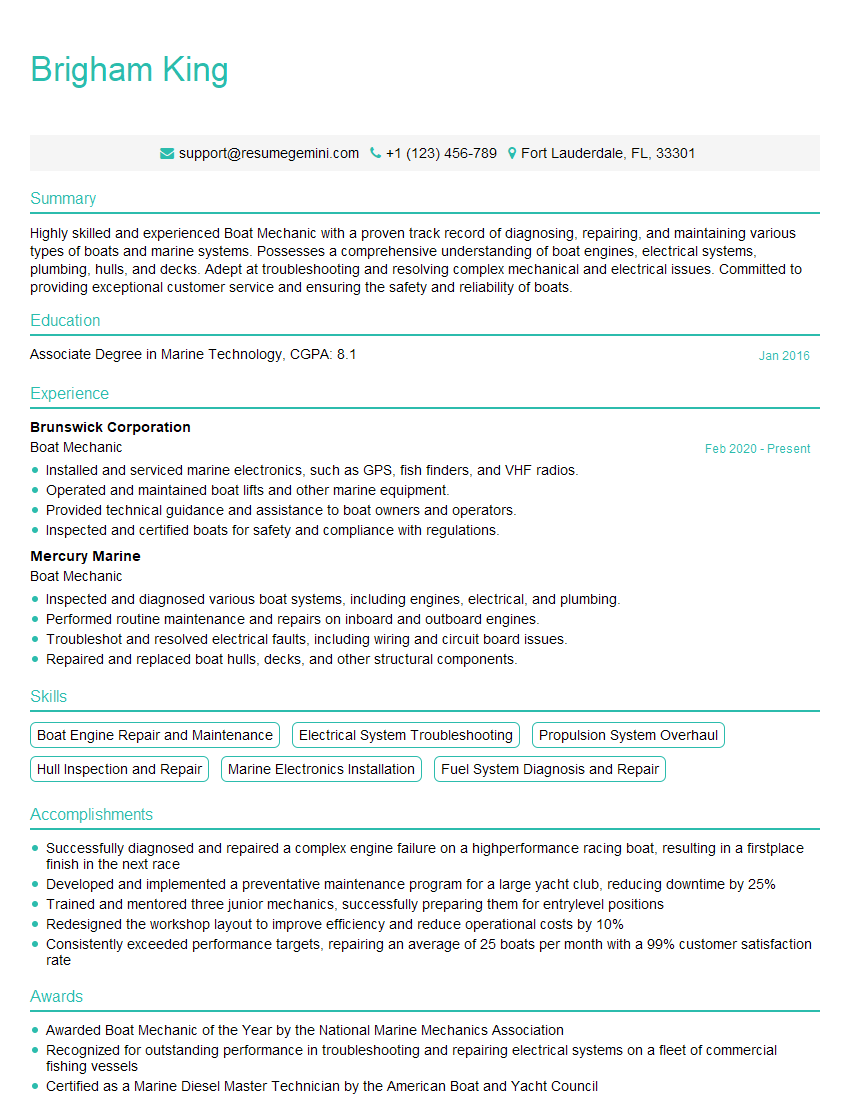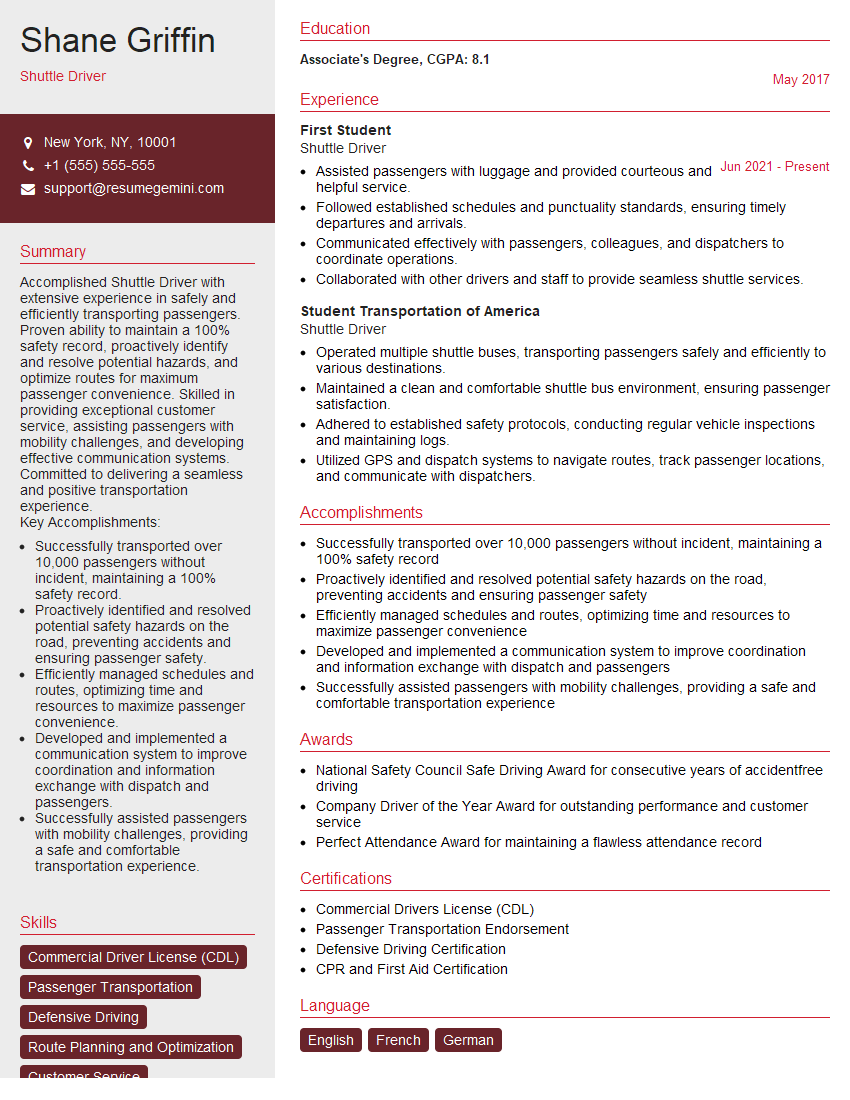Interviews are more than just a Q&A session—they’re a chance to prove your worth. This blog dives into essential River Rafting Operations interview questions and expert tips to help you align your answers with what hiring managers are looking for. Start preparing to shine!
Questions Asked in River Rafting Operations Interview
Q 1. Describe your experience with different types of river rafts.
My experience encompasses a wide range of river rafts, from small inflatable kayaks ideal for solo trips or navigating tight spaces to large, self-bailing rafts capable of carrying up to 12 passengers. I’m proficient with different materials, including PVC, polyurethane, and hypalon, each possessing unique strengths and weaknesses. For instance, PVC rafts are budget-friendly and durable for calmer rivers, while hypalon rafts are known for superior abrasion resistance and longevity, making them perfect for challenging, rocky rivers. I’ve also worked extensively with various raft designs – from simple open-top rafts to those with inflatable floors for added comfort and stability. This variety ensures I can select the appropriate raft based on the river’s conditions, group size, and client experience levels. A recent trip to the Colorado River involved using a fleet of 12-person self-bailing rafts due to the anticipated high water levels and the larger group size. On a smaller, technical river in the Cascades, I preferred utilizing smaller, more maneuverable rafts.
Q 2. What are the key safety procedures for river rafting?
River rafting safety is paramount. Our procedures begin with pre-trip briefings covering everything from proper paddling techniques and raft commands to emergency procedures. Each participant receives a thorough safety orientation and is fitted with appropriate personal protective equipment (PPE), including helmets and life jackets. Throughout the trip, we maintain constant vigilance, scanning the river for potential hazards and ensuring everyone remains within sight and within the raft’s capabilities. Swift water rescue equipment, including throw bags, ropes, and rescue devices, is readily accessible and our team is rigorously trained in their usage. We also enforce strict guidelines regarding alcohol and drug consumption before and during the trip and emphasize the importance of adhering to instructions. Regular checks of equipment, both before and during trips, are essential to ensure everything is in top condition. For example, a simple pre-trip inspection of paddle floats or checking for any damage on the raft itself is crucial.
Q 3. How do you assess river conditions and make decisions based on risk?
Assessing river conditions involves a multi-faceted approach. We begin by studying hydrological reports, weather forecasts, and historical river data. This allows us to predict water levels, flow rates, and potential hazards. On-site assessment is crucial, where we directly observe the river’s flow, identify obstacles like rocks, strainers (partially submerged debris), and hydraulics (powerful recirculating currents). We use established scales like the International Scale of River Difficulty (IRSD) to classify rapids and evaluate risk. Decision-making involves carefully weighing factors such as group experience, weather conditions, and the predicted river behavior. If conditions significantly exceed our risk tolerance, we may postpone or adjust the trip to mitigate potential dangers. For example, if a rapid is deemed too dangerous due to increased water flow, we might opt for an alternative route or choose to portage (manually carry the raft) around the obstacle.
Q 4. Explain your experience with swiftwater rescue techniques.
I am certified in swiftwater rescue techniques and have extensive field experience. My training covers various rescue scenarios, including self-rescue, assisting a swimmer in the water, and rescuing an unconscious person from a swift current. This involves using different techniques, such as throwing ropes, using a throw bag, and performing a swift water rescue. I am proficient in using specialized equipment such as throw bags, safety lines, and rescue boats. I have successfully employed these techniques in numerous real-world scenarios, including rescuing clients caught in hydraulics and managing situations where rafts have overturned. Regular training and practice drills are essential to maintain proficiency and adapt to ever-changing river conditions. A recent incident involved rescuing a client who had fallen out of their raft. Utilizing a swiftwater rescue technique, we successfully recovered the individual and ensured their safety.
Q 5. What is your experience with different types of rapids?
My experience spans a wide range of rapids, from calm Class I sections suitable for beginners to challenging Class V rapids demanding extensive expertise and technical skill. I’m familiar with the characteristics of different types of rapids, including their size, gradient, and the types of hazards they present. For example, Class II rapids are generally manageable with basic paddling skills, while Class IV and V rapids involve significant risk and require precise boat control, strategic paddling, and a strong understanding of swiftwater rescue. I’ve led trips on rivers featuring various rapid types, adapting my approach and risk management strategies based on the specific challenges presented. The knowledge of reading water and anticipating the behavior of each rapid is something that comes with years of experience and countless trips.
Q 6. How do you manage a group of diverse clients on a rafting trip?
Managing diverse client groups necessitates a highly adaptable and communicative approach. Prior to the trip, I conduct thorough pre-trip briefings to assess participants’ skill levels and experience. This allows me to tailor instructions and assign roles based on individual capabilities. I prioritize creating a positive and inclusive atmosphere where everyone feels comfortable participating. Clear communication, patience, and empathy are key in addressing individual needs and concerns. Addressing any anxieties or fears openly ensures a safer and more enjoyable experience for everyone. I encourage collaboration and teamwork to foster a sense of camaraderie and shared accomplishment. For example, I will pair more experienced paddlers with those who are less experienced to provide support and build confidence.
Q 7. Describe your experience with maintaining and repairing rafting equipment.
Maintaining and repairing rafting equipment is a crucial aspect of ensuring safety and trip success. I’m skilled in performing routine inspections, identifying wear and tear, and carrying out minor repairs. This includes patching punctures, replacing valves, and addressing minor fabric damage. I’m also adept at preventative maintenance, such as cleaning and inspecting equipment after each trip to identify and correct potential problems before they escalate. We maintain a well-stocked supply of repair materials, allowing us to address most issues in the field. Regularly scheduled equipment checks are critical for overall safety; for example, ensuring air pressure in inflatable rafts is adequate, and checking the condition of straps and D-rings before each trip.
Q 8. What is your knowledge of river ecology and environmental protection?
My understanding of river ecology is crucial to responsible river rafting operations. It encompasses knowledge of the river’s ecosystem, including its flora, fauna, and the delicate balance within. This includes understanding the impact of human activity, like rafting, on water quality, riparian habitats, and the overall health of the river. Environmental protection involves minimizing our footprint. For example, we meticulously plan itineraries to avoid sensitive areas, educate clients about Leave No Trace principles – packing out all trash, avoiding disturbing wildlife, and staying on designated trails. We also actively support organizations involved in river conservation and restoration efforts, contributing financially or through volunteer work. A specific example would be working with a local group to remove invasive plant species along a riverbank to protect native biodiversity.
- Water Quality Monitoring: Regularly testing water quality helps identify pollution sources and inform decisions about trip locations and safety.
- Habitat Preservation: We educate clients about the importance of not disturbing nesting birds or other wildlife along the river banks.
- Waste Management: Strict adherence to Leave No Trace principles ensures that our rafting trips leave no negative impact on the river’s ecosystem.
Q 9. How do you handle emergency situations on the river?
Handling emergencies on the river requires a swift, calm, and decisive approach. Our team undergoes rigorous training in swift water rescue techniques, including using ropes, throw bags, and inflatable rescue boats. We have established detailed emergency protocols, including communication systems (satellite phones, VHF radios) and pre-planned evacuation routes. For instance, if a client falls overboard in rapids, our trained guides immediately initiate a rescue using established protocols. This includes assessing the situation, stabilizing the victim, using appropriate rescue equipment, and then getting them to safety and medical attention if necessary. We also conduct regular drills to practice our response to various scenarios like capsized rafts, injuries, or flash floods.
- Swift Water Rescue Techniques: Proficiency in swift water rescue techniques is essential for effective response.
- Communication Systems: Reliable communication is crucial for coordinating rescue efforts and contacting emergency services.
- Emergency Action Plans: Detailed pre-planned action plans are practiced regularly to ensure efficient and timely responses.
Q 10. What is your experience with trip planning and logistics?
Trip planning and logistics are paramount for a successful and safe rafting adventure. It starts with choosing appropriate river sections based on water level, client experience, and season. This involves studying river maps, gauging water flows, and assessing potential hazards. We then meticulously plan the itinerary, including shuttle logistics, campsite locations (if applicable), meal planning, and equipment checks. This also includes managing permits and obtaining necessary licenses from the governing bodies. For a multi-day trip, we create detailed schedules, considering potential delays due to weather or river conditions. We carefully choose campsites that minimize environmental impact and ensure client comfort. For example, we would plan extra time for a trip that involved navigating challenging rapids or anticipated potential inclement weather.
- Route Planning: Thoroughly assessing the river conditions and choosing appropriate routes for client skill levels.
- Logistics Management: Efficiently managing transportation, permits, equipment, and campsite reservations.
- Contingency Planning: Incorporating backup plans for unforeseen circumstances, like weather changes or equipment malfunctions.
Q 11. Explain your knowledge of river navigation and map reading.
River navigation and map reading are fundamental skills for safe and efficient river trips. We use topographic maps, hydrological charts, and GPS devices to navigate. I’m proficient in interpreting river features like rapids, eddies, and hydraulics from maps and aerial imagery. This allows us to anticipate challenges and plan routes accordingly. In practice, this means understanding how water flows around bends, recognizing the potential for hazards like strainers or undercut rocks, and planning the route to avoid or mitigate these dangers. On-the-water navigation is about using natural clues, such as the river’s flow, vegetation, and landmarks, to confirm the map’s accuracy and adjust our route as needed.
- Topographic Map Reading: Interpreting elevation changes, terrain features, and identifying potential hazards.
- Hydrological Data Interpretation: Understanding river flow rates and predicting water level changes.
- GPS Navigation: Utilizing GPS technology to track our location and navigate accurately.
Q 12. How do you ensure client safety during different weather conditions?
Client safety is our top priority, and this extends to managing different weather conditions. Before each trip, we check weather forecasts and adjust plans based on potential hazards. This can involve postponing a trip if severe weather is anticipated or changing the itinerary to avoid exposure to dangerous conditions. For example, if thunderstorms are predicted, we may choose a shorter route or seek shelter. During trips, we monitor weather closely and have contingency plans in place. We provide clients with appropriate rain gear, and teach them techniques to stay safe during rain or high winds. We know how to react to sudden changes in weather such as a flash flood, which necessitates a rapid evacuation to safety.
- Weather Monitoring: Regularly checking weather forecasts and making adjustments as needed.
- Safety Gear: Providing clients with appropriate rain gear and other safety equipment.
- Emergency Procedures: Having established procedures for dealing with severe weather events.
Q 13. Describe your experience with guest communication and conflict resolution.
Effective guest communication and conflict resolution are essential for a positive rafting experience. Before the trip, I ensure clients understand the risks involved, safety procedures, and trip expectations. Throughout the trip, I maintain open communication, addressing concerns promptly and professionally. I also make a point of getting to know the clients, understanding their needs and preferences, which makes for a more enjoyable experience. In case of a conflict, I use active listening to understand all perspectives, focusing on finding mutually acceptable solutions. For example, I might address a disagreement over paddling techniques by providing clear instructions and individual attention.
- Pre-Trip Briefing: Clearly communicating trip expectations, safety procedures, and risk assessment.
- Open Communication: Maintaining open communication throughout the trip to address client concerns.
- Conflict Resolution: Employing effective conflict resolution strategies to address disagreements professionally.
Q 14. What is your understanding of legal and regulatory requirements for river rafting?
Understanding legal and regulatory requirements is crucial for operating legally and responsibly. This involves familiarity with permits, licenses, and regulations pertaining to river use, safety standards, and environmental protection. These vary depending on the location and governing bodies. We ensure compliance with all relevant laws and regulations, including those related to water rights, wildlife protection, and waste disposal. For example, we obtain the necessary permits before operating on any river section, and we adhere to guidelines for minimizing environmental impact, ensuring all our activities are compliant with local, state, and federal regulations.
- Permitting and Licensing: Obtaining and maintaining all necessary permits and licenses for operating on specific rivers.
- Safety Regulations: Adhering to all safety standards and guidelines established by relevant authorities.
- Environmental Regulations: Complying with all environmental regulations to protect the river ecosystem.
Q 15. How do you conduct pre-trip briefings and safety checks?
Pre-trip briefings and safety checks are paramount to a successful and safe river rafting trip. They’re not just a formality; they’re a crucial opportunity to establish clear expectations, assess risks, and ensure everyone is prepared. My approach involves a multi-stage process.
- Equipment Check: I begin by meticulously inspecting each raft, ensuring all seams are secure, air pressure is optimal, and safety equipment like oars, throw bags, and bilge pumps are functioning correctly and readily accessible. I also check personal flotation devices (PFDs) for each participant, verifying proper fit and functionality.
- River Conditions Briefing: Next, I thoroughly discuss the day’s river conditions, explaining expected water levels, rapids, potential hazards (e.g., strainers, submerged rocks, hydraulics), and weather forecasts. I use visual aids like maps and photos to illustrate key areas and potential challenges. For example, I might point out a particularly challenging rapid and explain the preferred paddling technique to navigate it safely.
- Safety Procedures: I cover essential safety protocols including emergency procedures (e.g., swimmer rescue, raft self-rescue), communication signals, and the importance of following instructions. Participants are actively involved in practicing key commands like ‘high side,’ ‘low side,’ and ‘forward paddle’.
- Personal Responsibilities: I emphasize individual responsibility for their safety and the safety of others, stressing the importance of listening attentively, following instructions, and communicating any concerns or discomfort immediately. This includes a clear understanding of the limits of their own abilities.
For instance, on a recent trip with a group containing novice rafters, I dedicated extra time to practicing ‘swim rescues’ in a calm section of the river, ensuring everyone felt confident in their ability to assist a fellow rafter in an emergency situation.
Career Expert Tips:
- Ace those interviews! Prepare effectively by reviewing the Top 50 Most Common Interview Questions on ResumeGemini.
- Navigate your job search with confidence! Explore a wide range of Career Tips on ResumeGemini. Learn about common challenges and recommendations to overcome them.
- Craft the perfect resume! Master the Art of Resume Writing with ResumeGemini’s guide. Showcase your unique qualifications and achievements effectively.
- Don’t miss out on holiday savings! Build your dream resume with ResumeGemini’s ATS optimized templates.
Q 16. What is your experience with first aid and CPR administration?
I hold current certifications in Wilderness First Responder (WFR) and CPR, and I regularly attend refresher courses to maintain my skills and knowledge. My experience encompasses a wide range of scenarios, from minor cuts and scrapes to more serious injuries such as sprains, fractures, and hypothermia. I’m comfortable performing initial assessments, providing appropriate first aid, and stabilizing patients until professional medical assistance arrives.
In a river rafting context, swift action and efficient treatment are critical. I’ve had to manage situations involving hypothermia in cold water, treating injuries sustained in falls, and coordinating evacuations. Knowing how to effectively package an injured person for evacuation, while ensuring their stability and safety is crucial. I prioritize minimizing further risk during the rescue itself. This requires a calm and methodical approach, even under pressure.
Q 17. Describe your approach to risk management in river rafting operations.
Risk management in river rafting is a proactive and layered approach. It’s not just about reacting to problems; it’s about anticipating and mitigating them before they arise.
- Pre-Trip Planning: This involves thoroughly assessing the river conditions, including water flow, weather forecasts, and potential hazards. We choose appropriate routes based on the experience level of the participants and adjust the route or itinerary as necessary based on the assessment.
- Communication and Teamwork: Clear and consistent communication among the team is key. Regular check-ins during the trip ensure everyone is aware of potential changes in river conditions or participant well-being.
- Contingency Planning: We develop detailed contingency plans for various scenarios, including equipment malfunctions, medical emergencies, and sudden weather changes. This includes pre-determined evacuation routes and communication protocols.
- Ongoing Monitoring: Throughout the trip, we continuously monitor river conditions and participant behavior. Any changes that increase risk levels are promptly addressed, potentially involving route adjustments or other preventative measures.
- Post-Trip Review: After each trip, we conduct a thorough review of the events, identifying areas for improvement and documenting any incidents or near misses. This allows us to constantly refine our risk management strategies.
For instance, if a sudden thunderstorm is forecast mid-trip, we have a pre-planned alternative route to a safer location with emergency shelter. We always carry multiple communication devices to ensure we maintain contact in remote areas.
Q 18. How do you adapt to changing river conditions and unexpected events?
Adaptability is crucial in river rafting. River conditions are constantly changing, influenced by factors like rainfall, snowmelt, and even the time of day. Unexpected events, from equipment failures to medical emergencies, can occur at any moment.
My approach involves a combination of:
- Continuous Monitoring: I constantly monitor river conditions, using visual observation, river gauges, and weather reports to assess any changes. This informs real-time decision making.
- Flexible Planning: Our trip plans are flexible, not rigid. We have backup plans for various scenarios, and we aren’t afraid to deviate from the original route if necessary to prioritize safety.
- Communication and Collaboration: Effective communication with the team (guides and clients) is vital for coordinating swift and appropriate responses to unexpected events. This includes clear signaling and shared situational awareness.
- Problem-Solving Skills: I apply my problem-solving abilities to evaluate risks, identify solutions, and implement them efficiently. I’ve had to improvise repairs on rafts, adjust paddling strategies, and manage unexpected medical situations.
For example, if a rapid proves unexpectedly challenging due to higher-than-anticipated water levels, we might elect to scout it from shore, communicate a modified approach to clients, or even portage (carry the raft) around the problematic section to ensure everyone’s safety.
Q 19. What is your experience with working in a team environment?
I have extensive experience working in collaborative team environments, both as a leader and a team member. River rafting necessitates seamless teamwork between guides and support staff to ensure the safety and enjoyment of all participants.
My contributions to a team include:
- Communication: Clearly and effectively communicating expectations, plans, and potential risks to team members.
- Collaboration: Working cohesively with other guides to execute rescue maneuvers or manage challenging situations.
- Leadership: Taking initiative and demonstrating strong leadership qualities when needed, especially during emergencies. This includes delegating tasks and making crucial decisions under pressure.
- Support: Providing support to other team members, offering assistance when needed and sharing knowledge and experience.
I’ve been part of teams that have navigated unexpected challenges like severe weather events and medical emergencies. Successful navigation of such situations relies entirely on effective teamwork, shared responsibility, and clear, calm communication.
Q 20. How do you effectively communicate with your team during a rafting trip?
Effective communication is the backbone of a successful rafting trip, crucial for both safety and enjoyment. My approach combines verbal and non-verbal communication techniques.
- Clear and Concise Instructions: I use clear, concise, and unambiguous language when giving instructions, ensuring all participants understand the commands.
- Visual Cues: I employ visual cues and hand signals to aid communication, especially in noisy or challenging environments. This is particularly important during rapids when verbal commands might be difficult to hear.
- Regular Check-Ins: I regularly check in with team members and participants to assess their understanding, well-being, and any concerns they might have. This fosters a sense of trust and open communication.
- Active Listening: I actively listen to concerns or questions raised by my team and participants. Addressing these concerns promptly and effectively builds trust and reassures everyone.
For example, during a challenging rapid, clear and concise commands, coupled with synchronized hand signals, are essential to ensure the safety and efficiency of the entire team. I also use humor and positive reinforcement to help keep the atmosphere engaging and cooperative.
Q 21. How do you maintain positive morale and enthusiasm among clients?
Maintaining positive morale and enthusiasm is just as critical as safety. It creates a more enjoyable and memorable experience for clients.
My strategies include:
- Pre-Trip Excitement: I start by generating excitement before the trip, sharing information about the river, its history, and the anticipated experience. This helps clients get mentally prepared for the adventure.
- Positive Reinforcement: Throughout the trip, I frequently provide positive reinforcement, praising teamwork and celebrating successful navigation of rapids. This boosts confidence and morale.
- Humor and Engagement: I use appropriate humor and lightheartedness to create a fun and engaging atmosphere. Sharing interesting stories or facts about the river and surrounding environment adds another layer of enjoyment.
- Personalized Attention: I make an effort to get to know the clients individually, understanding their interests and experience levels. This personalized touch shows that I care about their experience.
- Post-Trip Reflections: After the trip, I encourage reflection on the positive aspects of the experience and the teamwork achieved. This leaves a lasting positive impression.
For example, I might share a local legend associated with a particular section of the river, adding a touch of mystery and excitement. Celebrating a successful run through a challenging rapid with high fives and cheers is also a key element in boosting morale and creating lasting memories.
Q 22. Describe your experience with leading and motivating a team.
Leading a river rafting team requires a blend of strong technical skills and effective communication. My approach focuses on fostering a collaborative environment where each member feels valued and empowered. I begin by clearly defining roles and responsibilities, ensuring everyone understands their contribution to the overall safety and enjoyment of the trip. I then actively solicit input from my team, valuing their experience and perspectives. For example, during pre-trip planning, I’ll discuss potential hazards with the guides and collaboratively develop contingency plans. This collaborative approach builds trust and increases morale, resulting in a highly efficient and motivated team. Furthermore, I believe in leading by example – demonstrating professionalism, commitment to safety, and a positive attitude in every situation. I also actively provide feedback, both positive and constructive, to help each team member grow and improve their skills.
Beyond the technical aspects, I regularly organize team-building activities, such as after-work gatherings or training sessions focusing on teamwork and problem-solving. These activities foster camaraderie and help build stronger bonds between team members, which is crucial in handling challenging situations on the river. A recent example involved a challenging rapid where quick thinking and collaborative effort were essential to successfully navigate the group. The team’s coordinated efforts showcased the effectiveness of our teamwork and boosted their confidence immensely.
Q 23. How do you handle challenging or difficult clients?
Handling difficult clients requires patience, empathy, and a proactive approach. My strategy involves active listening and attempting to understand their concerns. I always strive to address their issues directly and honestly. If a client has a complaint, I immediately address it, acknowledging their feelings and offering a sincere apology if appropriate. I then work to find a solution that meets their needs while maintaining the safety and integrity of the operation. For instance, if a client is unhappy with the pace of the trip, I’ll explore options like adjusting the itinerary or providing additional guidance. If a safety concern is raised, I thoroughly investigate it, and even if it proves unfounded, I explain my reasoning clearly and transparently.
Occasionally, despite best efforts, client dissatisfaction may persist. In such cases, my priority shifts to de-escalation. I maintain a calm and respectful demeanor, providing clear explanations and offering alternative solutions where possible. If a compromise cannot be reached, I’ll involve my supervisor or management to ensure the situation is handled fairly and professionally. Documentation of the interaction is crucial to support future decision-making and help prevent similar issues from arising again.
Q 24. What is your experience with different types of rescue equipment?
My experience with rescue equipment is extensive, encompassing various types used in river rafting operations. This includes throw bags for reaching stranded individuals, safety kayaks for swift water rescues, specialized ropes and pulleys for complex extractions, and personal flotation devices (PFDs) of various types for all participants. I am proficient in using swiftwater rescue techniques, such as the use of a throw bag to extend a rope to a stranded person, performing a river rescue using a safety kayak, and employing a pulley system for complex situations like high-angle rescues. I’m also trained in the proper maintenance and inspection of all equipment, ensuring it’s in top working condition before each trip.
Beyond individual equipment, I’m familiar with the deployment and use of inflatable rescue boats (IRBs) which are essential for rapid responses in larger-scale incidents. I understand the importance of regular equipment checks and am skilled in identifying and addressing potential malfunctions. My training includes regular refresher courses focusing on equipment updates and best practices for maintaining optimal safety standards. Understanding and practicing safe handling and storage procedures is critical. An incident such as a faulty throw bag can have serious consequences, so consistent checks and maintenance are paramount.
Q 25. How do you prioritize safety while still providing an enjoyable experience?
Prioritizing safety while ensuring an enjoyable experience is a delicate balancing act, requiring a proactive and comprehensive approach. My approach begins with pre-trip briefings where safety protocols are clearly communicated and expectations are set. I emphasize the importance of following instructions and using safety equipment correctly. Risk assessment is crucial, I carefully evaluate the river conditions, weather forecasts, and participants’ skill levels before making decisions about the route and activities. I’ll alter the plan if necessary, opting for a less challenging route if conditions are unfavourable.
On the river, I maintain constant vigilance, monitoring the group’s progress and addressing any potential hazards promptly. Effective communication and clear instructions are paramount; I explain the potential risks and necessary precautions, ensuring everyone understands their roles. While safety is non-negotiable, I also strive to create a fun and engaging experience. I incorporate elements that enhance the adventure, such as highlighting interesting geological features or sharing stories about the river’s history. This holistic approach ensures that safety isn’t perceived as a hindrance to the enjoyment, but rather an integral part of a successful and unforgettable rafting experience.
Q 26. Explain your experience with post-trip debriefing and feedback.
Post-trip debriefing is an integral part of my operational process, serving as a valuable tool for continuous improvement and identifying areas for enhancement. Immediately after each trip, I conduct a debriefing session with my team, discussing the trip’s successes and challenges. This includes reviewing the effectiveness of safety protocols, identifying areas where improvement is needed, and addressing any issues or incidents that occurred.
This process involves both verbal discussion and written documentation. I encourage open and honest feedback from every team member, and the discussion aims to analyze performance without assigning blame. We discuss situations where safety protocols were followed successfully, and scenarios where they may need modifications or extra clarification. The feedback also informs trip planning for future trips. For example, if a certain rapid proved particularly challenging, we might adjust the route or modify the instruction provided to participants. This post-trip debriefing process not only ensures continuous improvement in safety and operational efficiency but also strengthens team cohesion and boosts morale by valuing each individual’s contribution to the success of the trip.
Q 27. How do you stay up-to-date on industry best practices and safety standards?
Staying updated on industry best practices and safety standards is a continuous process requiring proactive engagement. I regularly attend workshops, seminars, and conferences organized by professional organizations like the American Whitewater Association (AWA). These events provide access to the latest safety guidelines, rescue techniques, and industry innovations. I also actively participate in online forums and communities where river guides and professionals share their knowledge and experiences.
Furthermore, I meticulously review publications, journals, and online resources that focus on river safety and rescue techniques. These resources often include case studies of incidents and near misses, providing valuable lessons and insights. I actively seek out and participate in advanced training courses in areas such as swiftwater rescue and wilderness first aid to maintain my skills and certification. Staying informed isn’t merely about complying with regulations; it is about constantly refining my knowledge and skills, ensuring the safety and well-being of my clients and team.
Q 28. Describe your experience with developing and implementing safety protocols.
Developing and implementing safety protocols is a crucial aspect of my role. It starts with a comprehensive risk assessment that identifies potential hazards, such as rapids, weather conditions, and client skill levels. Based on this assessment, I develop a detailed plan that outlines emergency procedures, equipment checks, and communication strategies. The protocols clearly define roles and responsibilities for each team member, ensuring efficient response to any incident. This might include assigning specific individuals to monitor weather conditions, check equipment, or lead rescue operations.
Implementation involves regular training sessions for the team to ensure everyone is familiar with the protocols and competent in their designated roles. I use scenario-based training exercises to simulate real-life situations, fostering a proactive approach to safety. I continuously review and update these protocols, incorporating feedback from the team and lessons learned from past trips. This iterative process ensures that the protocols remain relevant and effective, reflecting the latest safety standards and adapting to changing conditions. I also ensure that all participants are adequately briefed on these protocols before each trip, emphasizing the importance of their adherence.
Key Topics to Learn for River Rafting Operations Interview
- River Safety and Risk Management: Understanding swiftwater rescue techniques, hazard identification (e.g., rapids, strainers, hydraulics), and risk mitigation strategies. Practical application includes describing your experience in developing and implementing safety plans.
- Guest Experience and Communication: Techniques for effectively communicating safety procedures and instructions to diverse groups, managing guest expectations, and ensuring a positive and memorable experience. Consider how you’d handle a challenging guest or unexpected situation.
- Trip Planning and Logistics: Knowledge of route planning, considering water levels, weather conditions, and group capabilities. Practical application includes outlining your experience in pre-trip preparation and decision-making during a trip.
- Equipment Maintenance and Repair: Understanding the proper maintenance and repair procedures for rafts, paddles, safety gear, and other essential equipment. Be prepared to discuss your practical experience with equipment care and troubleshooting.
- Environmental Awareness and Stewardship: Knowledge of Leave No Trace principles, environmental regulations, and responsible river management practices. Highlight your commitment to sustainability in your work.
- Teamwork and Leadership: Demonstrating effective teamwork skills, conflict resolution, and leadership abilities in a dynamic and potentially stressful environment. Be ready to provide specific examples of your leadership and teamwork in a river setting.
- First Aid and Emergency Response: Knowledge of basic first aid and wilderness emergency response procedures, including swiftwater rescue techniques. Highlight any relevant certifications or training you’ve completed.
Next Steps
Mastering River Rafting Operations is crucial for career advancement in this exciting and rewarding field. A strong understanding of these key areas will significantly improve your interview performance and open doors to a variety of opportunities. To enhance your job prospects, it’s vital to create an ATS-friendly resume that highlights your skills and experience effectively. We strongly encourage you to leverage ResumeGemini, a trusted resource for building professional resumes. ResumeGemini provides helpful tools and examples of resumes tailored to River Rafting Operations to help you present yourself in the best possible light. Take the next step towards your dream career – craft a compelling resume that showcases your expertise!
Explore more articles
Users Rating of Our Blogs
Share Your Experience
We value your feedback! Please rate our content and share your thoughts (optional).
What Readers Say About Our Blog
Hello,
We found issues with your domain’s email setup that may be sending your messages to spam or blocking them completely. InboxShield Mini shows you how to fix it in minutes — no tech skills required.
Scan your domain now for details: https://inboxshield-mini.com/
— Adam @ InboxShield Mini
Reply STOP to unsubscribe
Hi, are you owner of interviewgemini.com? What if I told you I could help you find extra time in your schedule, reconnect with leads you didn’t even realize you missed, and bring in more “I want to work with you” conversations, without increasing your ad spend or hiring a full-time employee?
All with a flexible, budget-friendly service that could easily pay for itself. Sounds good?
Would it be nice to jump on a quick 10-minute call so I can show you exactly how we make this work?
Best,
Hapei
Marketing Director
Hey, I know you’re the owner of interviewgemini.com. I’ll be quick.
Fundraising for your business is tough and time-consuming. We make it easier by guaranteeing two private investor meetings each month, for six months. No demos, no pitch events – just direct introductions to active investors matched to your startup.
If youR17;re raising, this could help you build real momentum. Want me to send more info?
Hi, I represent an SEO company that specialises in getting you AI citations and higher rankings on Google. I’d like to offer you a 100% free SEO audit for your website. Would you be interested?
Hi, I represent an SEO company that specialises in getting you AI citations and higher rankings on Google. I’d like to offer you a 100% free SEO audit for your website. Would you be interested?
good



